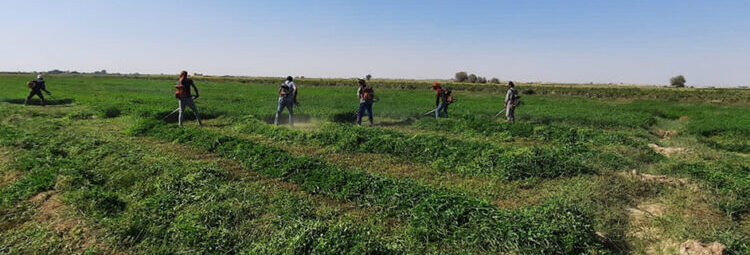Bandar, faced with recurring losses in seasonal crops, sought out alternative options to make up for the shortfall. The last setback he experienced was during the corn season last year. Determined to find a viable solution, he made the decision to switch to planting mint on his land as a new crop.
Bandar al-Sayed, a resident of the village of Ratla in southern Raqqa Governorate, northern Syria, told North Press that a devastating loss in the yellow corn season led him to plant his entire land with mint and abandon planting seasonal crops.
A new trend has emerged in agriculture in Raqqa, focusing on growing vegetables and herbs, especially green mint, due to their lower costs and higher returns compared to seasonal crops like cotton, wheat, and yellow corn.
“The lack of support for agriculture by the Autonomous Administration of North and East Syria [AANES] and its failure to purchase crops from farmers has played a significant role in the shift towards crops with continuous year-round production and daily consumption,” al-Sayed said.
Seasonal crops have become expensive for farmers due to the cost of seeds, fertilizers, and plowing, which farmers pay for in US dollars, while their cultivated crops are sold in Syrian pounds (SYP), according to the farmers.
The collapse of the Syrian pound’s value has caused significant losses for farmers due to disparities in exchange rates.
After the downturn in al-Sayed’s corn crop, which is not a unique case, he and his peers decided to plant green crops which have become increasingly prevalent in Raqqa at the expense of seasonal crops, especially in al-Kasrat area in southern Raqqa.
The reason farmers are turning to these crops is due to their higher income and lower costs. Mint, for example, is planted once every three years at a minimum, and farmers harvest it five times a year.
The average yield of one dunam (1,000 square meters of land) of mint each time is 200 kilograms, and it is sold for more than $1 per kilogram.
In addition to green crops, fruit tree cultivation has also spread significantly in Raqqa, covering approximately 50 percent of the lands in al-Kasrat area. However, al-Sayed says that the mint season is better than others.
The spread of agricultural pests and the rising costs of seasonal crops, especially intensive ones, have led some farmers to abandon agriculture.
Similarly, Faisal al-Darwish, 30, a farmer from the village of Kasrah Sheikh al-Jumaa in southern Raqqa, turned to mint cultivation. He says what led him to do so was productivity and low costs, as well as selling the product in US dollars.
Al-Darwish owns 5 hectares of land, half of which he planted with fruit trees, and the other half is being prepared for mint cultivation.
The cultivation of mint begins between the months of November and March each year. It involves a single planting that can persist and regenerate for three years.
Farmers sow the roots in the ground and water them for growth, as cultivating mint using roots is more successful than using seeds, which may require more time to grow.
The productivity of mint is stable, as it is linked to the US dollar. Al-Darwish estimates the production of one dunam to be between $800 and $1,000.
Faisal al-Faisal, 35, a resident of the village of Fakhikha in southern Raqqa, agrees that mint cultivation does not require a significant amount of water for irrigation.
The scarcity of irrigation water has become a pressing concern for farmers planting seasonal crops due to the declining water levels of the Euphrates River and the limited operation of irrigation stations. Turkey has been withholding the river’s water since February 2020, exacerbating the situation.
Faisal further explained to North Press that mint cultivation only costs farmers the price of the roots and the one-time plowing of the land every three or four years.
He adds that farmers can reuse the roots from one piece of land to another after purchasing them once. Additionally, mint cultivation does not require excessive fertiliser usage, as farmers struggle with high fertiliser prices and concerns about its quality. After mint cultivation, farmers harvest the mint every 40 days using manual tools, followed by the processes of spreading, drying, grinding, sifting, and packaging before selling it to local traders.

